Analysis: Here's what the data has to say about Ireland's migration trends in the wider European context
By Keire Murphy, TCD
It would be easy to get the impression from common narratives that Ireland has a lot more migrants or refugees than other European countries, but is this true? When it comes to the number of migrants and refugees in Ireland, we're in the middle cohort compared with other European countries. But when we look at the percentage of foreign-born residents, it’s somewhat more true (especially in recent years), although we’re still within a normal range in Western Europe.
Before we look at what the data has to say about Ireland's migration trends in the wider European context. there's one important caveat. Even if Ireland is not receiving a higher number of migrants than other European countries, there are still significant challenges.
Many other countries have been receiving migrants for longer, and therefore have more capacity in their asylum systems. One of the main challenges in Ireland is that we are suffering from major infrastructure deficits after years of low capital investment during austerity, while the population continued to grow.
We need your consent to load this rte-player contentWe use rte-player to manage extra content that can set cookies on your device and collect data about your activity. Please review their details and accept them to load the content.Manage Preferences
From RTÉ Radio 1's Morning Ireland, RTÉ Social Affairs Correspondent Ailbhe Conneely reportson growing concern an increasing number of recognised refugees could end up homeless because of a Department of Integration policy
Migrants as a percentage of the population
Let’s start with all immigrants, those who have come to Ireland for work, study, family and asylum. When we talk about immigrants, we can use two different definitions: those born abroad (estimated at 22% in 2023) or non-Irish citizens (around 14%). Neither of these are perfect measures. Looking at those born abroad captures Irish citizens born in Northern Ireland and Irish citizens born to Irish parents while abroad, who may subsequently have grown up in Ireland. On the other hand, looking at non-Irish citizens would exclude people who moved to Ireland and became Irish citizens.
Let’s go with the higher number (born abroad). This first graph shows the number of people born abroad as a proportion of the population. Ireland is quite high up the table in sixth place. It’s worth noting that Ireland was in 11th place on this list using the previous year's data (2022).
We need your consent to load this rte-player contentWe use rte-player to manage extra content that can set cookies on your device and collect data about your activity. Please review their details and accept them to load the content.Manage Preferences
From RTÉ Radio 1's Drivetime, the High Court rules Ireland is breaching the human rights of homeless asylum seekers
Part of this jump is because of an actual increase, and part of it is because of how (and when) we count migrants. Many mainland European countries have a population register (where people register when they leave or arrive) which allows the government to have up-to-date statistics on migration and the population.
Ireland doesn’t have this register so we rely on estimates from various sources (surveys, visa data from the main destination countries etc) between census years, and then correct our estimates based on the census. The 2022 census made it evident that the estimates for the last six years (delayed because of Covid-19) were a bit too low, so the data was corrected upwards in 2023.
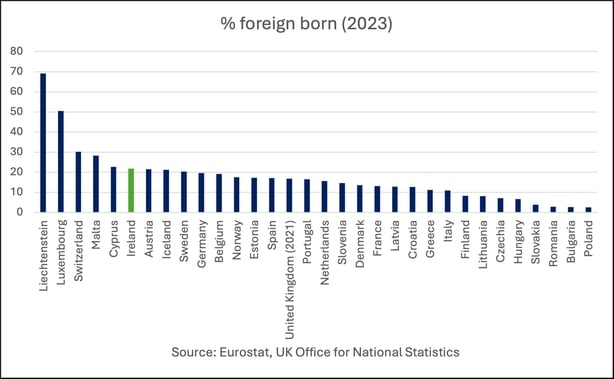
An estimate of 22% born abroad in 2023 therefore puts us quite high-ranking in the EU. This is not out of the normal range for Western European countries in particular - it's a similar percentage to Austria, Sweden, Germany, and Belgium - but it's at the high end of that range.
One important thing to note about this data is that the measure of those born abroad in countries like Belgium, Germany and the UK likely significantly undercounts those with a migrant background, as many migrant populations in these countries have been there for a long time. In Ireland, it’s likely to be more accurate, because our migrant populations are quite new, or an overcount because it counts both the children of Irish emigrants born abroad who then returned and people born in Northern Ireland. While many of those born in the country are not migrants by most definitions, they can be important parts of conversations about integration, so this is worth noting.
What about asylum seekers?
Of course, some groups are more discussed than others: asylum seekers account for a very small proportion of immigration in Ireland, but tend to get a lot of political and media attention. So how do we fare in the number of asylum seekers who arrive every year?
Let’s look at 2023, which was the second highest year on record (just behind 2022, both of which look likely to be surpassed this year). Remember that total asylum applications in Ireland in these two years were much, much higher than the previous 10 years. This excludes people fleeing the war in Ukraine, who fall under a separate system that I’ll turn to after this.
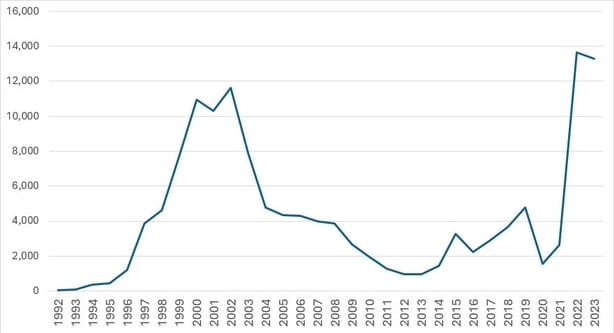
Source: Cunniffe, E., K. Murphy, E. Quinn, J. Laurence, F. McGinnity & K. Rush (2022) 'Explaining Recent Trends in International Protection in Ireland' (ESRI) and International Protection Office (2024) http://www.ipo.gov.ie/en/ipo/pages/statistics
Our research found that this increase is likely to be a result of multiple factors including a time of significant global instability, deflection from the UK (for some nationalities) and a long-term social network effect bringing Ireland up to more normal application numbers for a Western European country.
The next graph of total asylum application in 2023 shows that the number of asylum applications we receive is quite small compared with larger European countries. While it would be easy to say that we are also a very small country, it’s important to remember, in understanding Ireland in an EU context, that not all of those receiving large numbers are large countries. Austria, number 6 on the graph, with over 50,000 applications has a population of just 9 million, less than double the Irish population. This was also a big drop for Austria, which received over 100,000 applications in 2022, compared with 13,600 in Ireland.
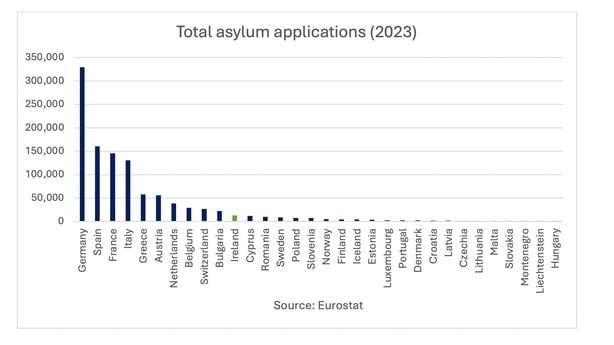
But let's have a look at the numbers compared with the population. This next graph shows the number of asylum seekers per 1,000 people. In 2023, Ireland actually moves down the table by one (from 11th to 12th) when we look at the numbers compared with the population. We also remain firmly within the middle group, not even close to the highest countries.
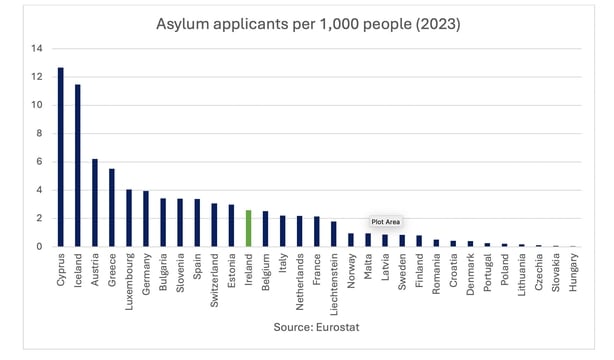
The Ukraine question
The first graph below shows the total number of people who have fled Ukraine for the EU, combining the arrivals for both 2022 and 2023. It again shows that Ireland is in the middle category and receiving only a fraction of the largest receiving countries. The second graph here shows temporary protection arrivals as a percentage of the population. The below graph shows the number of people fleeing Ukraine per 1,000 people, counting arrivals in both 2022 and 2023.
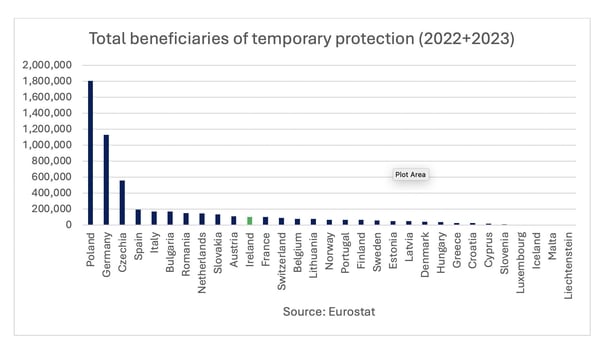
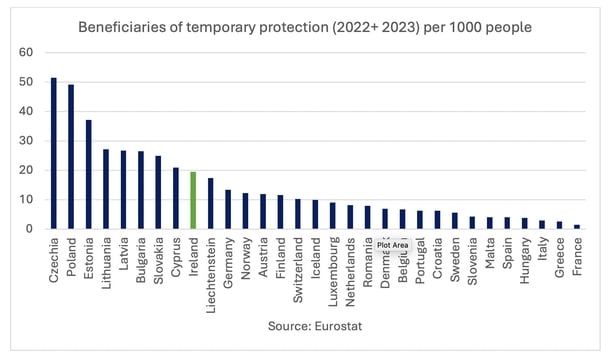
The second graph shows that Ireland ends up a little bit higher on the table when we look at population, but is still in only ninth place. What is interesting about this migration flow is that Ireland is higher than countries that would traditionally receive the largest numbers of forced migrants, like Germany, Austria, the Netherlands, and France. Surveys that have been conducted among Ukrainians in Ireland indicate that this is likely because Ireland is English-speaking, far from Russia and provided strong support for those fleeing Ukraine.
However, these figures likely overestimate the actual number who have remained in Ireland as some people may have moved on or returned to Ukraine. The CSO found in June 2024 that only 76% of arrivals from Ukraine had recent administrative activity in Ireland, indicating that as many as 24% may have left Ireland.
We need your consent to load this rte-player contentWe use rte-player to manage extra content that can set cookies on your device and collect data about your activity. Please review their details and accept them to load the content.Manage Preferences
From RTÉ Archives, Michael Walsh reports for RTÉ News on the first Vietnamese refugees to arrive in Ireland 45 years ago this month
Is Ireland receiving a lot more migrants, asylum seekers and people fleeing Ukraine than other European countries? No, in general we're in the middle (although we’re quite high on the percentage of foreign born). However, Ireland historically received very few forced migrants in particular, so even this move into the middle represents a big change from the past that Ireland needs to build capacity for.
Coming from a long period of low capital investment makes this even more challenging. The National Competitiveness and Productivity Council recently identified housing, energy and water as the most acute infrastructure shortages. The Irish Fiscal Advisory Council has also recently identified low infrastructure compared with other European countries in health and transport in particular. The fact that we are in the middle in most cases indicates that the challenges we are experiencing may be related to investment and planning rather than absolute or relative numbers.
Follow RTÉ Brainstorm on WhatsApp and Instagram for more stories and updates
Keire Murphy is a Policy Officer with the European Migration Network Ireland, based in the Economic and Social Research Institute. She is a Visiting Research Assistant at Trinity College Dublin.
The views expressed here are those of the author and do not represent or reflect the views of RTÉ

